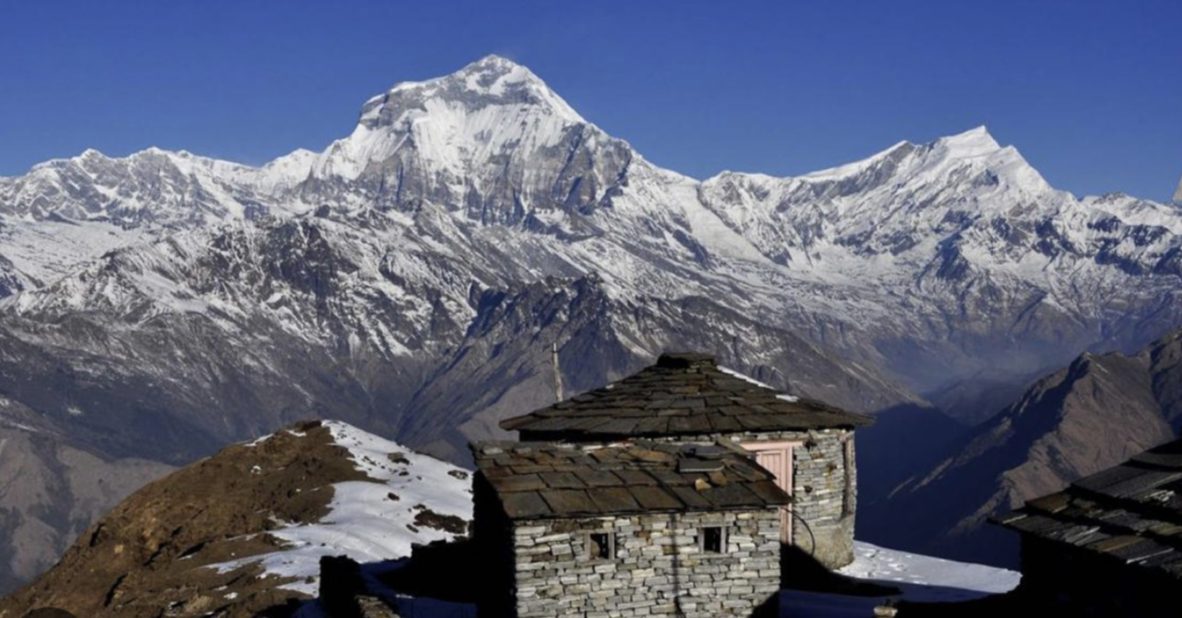Ghorepani-Poonhill-Ghandruk Trek Overview
The sheer grandeur of Nepal’s many landscapes and geographical features makes it unimaginably beautiful. There are many interesting, quaint, and worthwhile locations there. In actuality, Nepal’s distinctive landforms offer countless picturesque vistas for ardent hikers to explore and take in the breathtaking landscapes. Ghandruk, Poon Hill, and Ghorepani Trekking is inherently thrilling and seductive. It’s one of the most well-liked and easily accessible hiking locations. They don’t need to travel for days or weeks to reach the vantage point. Perhaps this explains why Ghorepani-Poon Hill-Ghandruk attracts so many tourists from all over the world. Since no other location offers a view of Annapurna, they swarm to Poon Hill. Visitors are astounded by the breathtaking views of Dhaulagiri, Machhapuchhare, Nilgiri Himal, Dhampus Peak, and many other locations throughout this short walk, which successfully captures the actual beauty of the hillside. It is equally enjoyable to stroll through Ghandruk village, particularly the peaceful surroundings and verdant terrace farm.
While visiting the village, visitors can see numerous Gurung and Tamang villages. While at Ghandruk, they can see some historic monasteries and vibrant prayer flags. Not to be overlooked are the long-wavelength hues of the dawn and sunset that are visible from the hilltop. With its short hiking pathways, Poon Hill is arguably the easiest trek. In the end, this makes it perfect for people who wish to see the peak but don’t want to go above and beyond or climb mountains.
At 10,500 feet, the hill station is located 270 kilometres west of Kathmandu. Ghandruk Villages, meanwhile, is 32 kilometres northwest of Pokhara. Although both private and public cars can get to the area, trekking is a more energising experience. Ghandruk, the entrance to Poon Hill, offers a breathtaking vista of shimmering mountains like Hiunchuli, Mt. Annapurna, and Mt. Gangapurna. The Gurung people live in Ghandruk hamlet, and religious shrines and other important structures serve as reminders of their culture and tradition. It is daunting to trek Ghandruk, Poon Hill, and Ghorepani. It has become a popular trek location for most travellers due to its easy climbing pathways and breathtaking views. Pokhara is where the journey to Ghorepani itself begins.
The 3,210-meter hill station is reached after a strenuous journey through hills and dense forest. The majority of trekkers’ time is spent admiring the breathtaking natural splendour that can be observed from the vantage point. They also take in the stunning scenery of shimmering mountains, striking scenery, verdant ferns, and cascading waterfalls. The trail descends the stairs and leads to Tirkhedhunga after the sightseeing. To reach Ghandruk, the journey continues along an uneven path that has some ups and downs. The Gurung and Tamang customs and culture are rich in this little community.Additionally, Ghandruk is a fantastic location for sunrise and sunset viewing. It provides a beautiful view of Hiunchuli, Mt. Gangapurna, and Mt. Machhapuchhare. The Ghorepani-Poon Hill-Ghandruk trip comes to a close at this point, and the hikers and Nepal Holiday Treks and Tours will be taken back to Kathmandu.
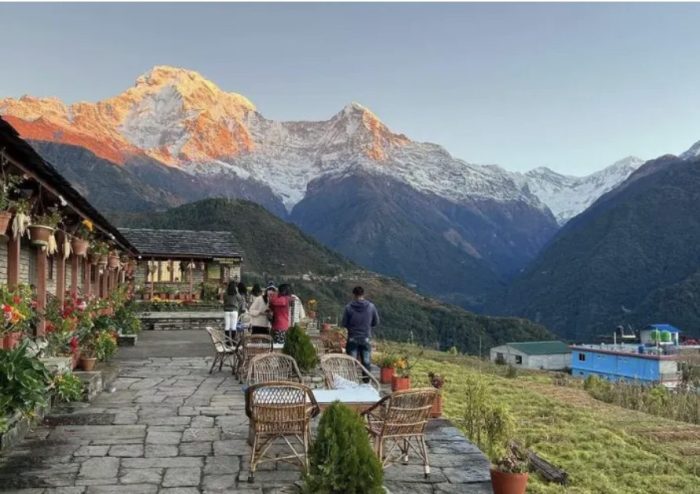
Best Season for Ghorepani Poonhill Ghandruk Trek:
- Autumn:
The trek is almost considered in demand during autumn. From September to November, the sky opens up for views of the Annapurna and Dhaulagiri ranges. This time of the year is humid, with daytime temperature ranging from 10 to 20 degrees Celsius-mild and perfect for trekking. Given that the rain would have washed away and made visible the sight of dust and pollution, it makes this the best time for clear visibility. The trails are dry as well, hence making the trek easier and safer. However, along with this best trekking season, crowded trails and teahouses, and an increase in accommodation prices are also accompanying this peak season. Furthermore, this period coincides with Dashain and Tihar, the biggest festival in Nepal. Thus, trekkers get to enjoy rich local culture.
- Spring:
The month of Spring being the next best season for the Ghorepani-Poon Hill-Ghandruk Trek is also the month when the peculiar red, pink, and white colors literally paint the trails with the rhododendrons blossoming at this time. The weather remains pleasantly warm, with daytime temperatures ranging between 15°C and 25°C. The odds usually favor a clear view from higher elevations, but some slight haze can be observed down at lower altitudes. Additionally, there are longer hours of daylight that come with the spring season when days are longer than in autumn. There are fewer crowds than fall, thus making the trekking experience feel more personal, though certain trails can get quite dusty as things dry out, and often, mist will hide the view of the mountains.
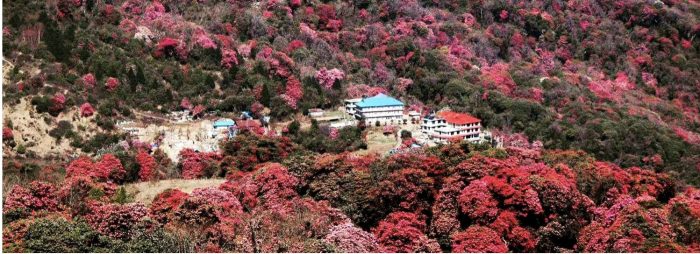
If you want to experience the snowfall and can bear cold the trek can also be done during the winter season. Due to heavy rainfall and leeches the trek is mostly avoided during the monsoon season.
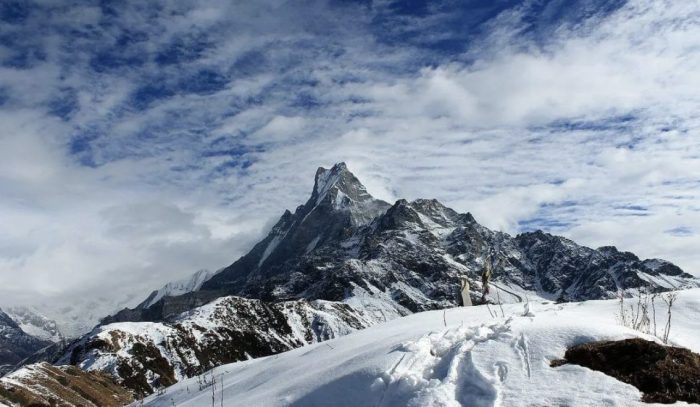
Culture and Tradition During Ghorepani-Poonhill-Ghandruk Trek:
The Ghorepani-Poon Hill-Ghandruk Trek rewards adventurers not only with some of the most beautiful mountain views and varied landscapes in Nepal but also with another angle of deeper cultural experience. This trek traverses traditional Magar and Gurung villages that have great ancestral heritage, peculiar customs, and warm-hearted hospitality.
Gurung-Magar Culture
The Gurung and Magar people constitute the dominant ethnic groups along this way of trek. These will take on a journey of such diverse cultures, rhythm, and lifestyles in villages like Ghorepani and Ghandruk. The Gurungs are famously brave Gurkha soldiers who have a long military history, while the Magars are better remembered for their folk culture. Both are friendly and hospitable people who often invite trekkers for a slice of their life.
Traditional Dress and Lifestyle
The festive occasions and cultural functions where traditional attire is still worn by men and women in these villages include Gorkha Dussehra, which celebrates the Gurung culture, and Maghe Sankranti, which is especially celebrated by the Magars. While Gurung men dress in a Bhangra-a short shirt-and Kachhad-a-type of wraparound skirt, their women wear the gunyu cholo-a traditional Nepalese dress. Many stone houses in Ghandruk show traces of old traditional architecture adorned by well-maintained courtyards.
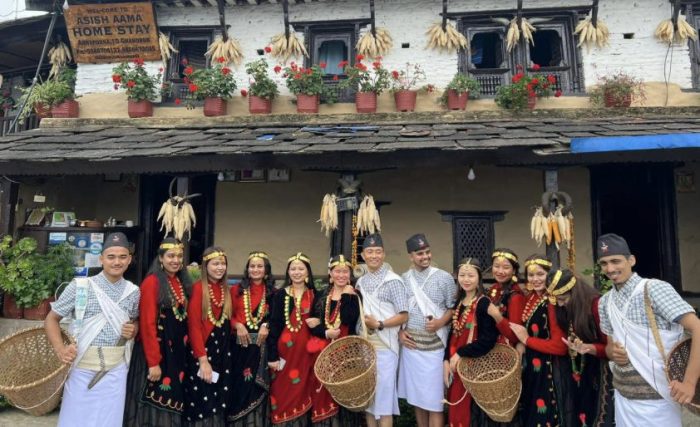
Celebration and Festivals
If trekking is scheduled for the festival season, important cultural functions can be observed. The Dashain and Tihar celebrations (in the fall) are when locals traditional dance, pray, and feast with families. The Magars and Gurungs celebrate their festivals, Lhosar (New Year) being the most notable one, with singing, dancing, and food. Rodhi Ghar, a cultural space for singing and storytelling, is of great significance in Gurung culture.
Religious and Spiritual Practices
Small Buddhist monasteries, chortens (stupas), and prayer wheels appear in many villages along the trek, for Gurung and Magar communities follow a mixture of Buddhism, Hinduism, and animistic practices. Calm chants of Buddhist prayers are often heard in the settlements, and prayer flags are seen billowing with the wind, sending blessings through the mountains.
Overall, the Ghorepani-Poon Hill-Ghandruk Trek is not only about nature but is culturally enriching too. Trekking through these villages provides one with a chance to experience the local way of life, warmth of hospitality, and centuries-old traditions that make this region truly special.
Food and Accommodation During the Ghorepani-Poonhill-Ghandruk Trek:
Food During the Trek:
Food in this trek is a mixture of Nepali, Tibetan, and many international cuisines. Most of the dishes have been customized according to the needs of the trekkers during the region’s staples such as rice, lentils, and vegetables, but are subject to change based on what can be sourced from the locales and seasons.
Dal Bhat: This dish is the basic meal of rice and lentil soup, and is the core of the Nepali diet. It’s nutrition-dense, very filling, and served with tarkari (vegetable curry), achar (pickle), and sometimes meat curry.
Gundruk: A local fermented leafy green delicacy, usually relished as a main dish accompanied to rice.
Momo: These dumplings are called a popular snack or light meal and are mostly stuffed with vegetables, chicken or buff (buffalo meat).
Dhido: Buckwheat or millet porridge, heated, is called thick and nutritious porridge as a substitute for rice that is made mainly in more remote villages.
Chapatti: These flatbreads made of whole wheat flour will be served with vegetable or meat curry on most occasions.
Tibetan Noodles: These noodles are simple yet filling and commonly available in higher-altitude villages.
Snacks: Trekkers can enjoy a wide variety of snacks including crisps, biscuits, chocolate bars, and tea at the teahouses.
Drinks:
Tea: The most common drink is made cooler: black tea, or cooled and sweetened: perhaps milk tea, or herbal tea.
Coffee: Also instant coffee is available much, but stronger due to the altitude.
Homemade alcoholic drinks like rice beer (Chyang) and local liquor (Raksi) are often offered to guests.
Accommodation Along the Trek
On Ghorepani-Poon Hill-Ghandruk Trek, hikers would stay inside teahouses or lodges that would offer basic accommodation, which is clean but comfortable. The room’s type would vary with the trek’s height and how popular a village was.
Basic Rooms: Generally, these rooms are simple with basic amenities such as wooden beds, blankets, and pillows. Similarly, some rooms may have a shared bathroom, especially in lower-altitude villages; higher up, you may have to share the facility outside the room.
Facilities: Although most teahouses provide a common area for dining, there are some that offer wifi (although it can go down often), charging stations (with a small fee at times), and hot showers (which are usually paid for).
Comfort: Therefore, as you keep climbing, the accommodation tends to get simpler and cruder, but the hospitality continues to be warm and welcoming. It may be expected to be very rustic in some areas, with shared rooms and very basic facilities.
Teahouses and Lodging Style: In the lower altitudes (Ghorepani, Nayapul, Ghandruk), the teahouses here are larger, better in facilities, and accommodate a larger number of trekkers. Some have more comfortable private rooms with hot showers.
In the higher altitudes (Tadapani, Deurali), teahouses become more basic as you ascend. In some places, rooms may share with other trekkers; hot showers may be available only for an extra charge and in fragile remote teahouses may have to go for cold showers.
Community Atmosphere: Teahouses provide a communal atmosphere for trekkers to meet, share experiences, and partake in hearty meals together. Most trekkers steer toward rejoining other trekkers in common dining areas, where they will happily converse with the locals joining in. In exchange, they learn about the culture and way of life from those who know it best.
Altitude During the Ghorepani-Poonhill-Ghandruk Trek:
The trek reaches its maximum altitude at Poon Hill, which lies at 3,210m (10,531ft), This altitude is really not that much as most trekkers will not usually suffer from altitude sickness. But it is still very important that you go slow and drink enough water and not overdo things just in case.
Though this trek does not go to very high altitudes, it still has some altitude gain, so take your time to acclimatize yourself. If traveling with a guide or a group, these will keep your pace on the journey so that you accustom yourself slowly to the elevation, especially while reaching Ghorepani and Poon Hill.
Here are some altitude tips:
Walk Gradually: Higher altitudes require more time for the body to acclimatize; hence, climb slowly and progressively.
Stay hydrated: Do not forget to drink plenty of water during the trek to avoid altitude problems.
Rest: Include regular breaks in your itinerary, especially when you are going to higher elevations.
This trek is ideal for trekkers, new entrants at high elevations, who want to have a little glimpse of the Himalayas and spectacular views.
Guide and Porter During Ghorepani-Poonhill-Ghandruk Trek:
All the trekkers are required to take services from licensed trekking guide and to obtain TIMS card from authorized trekking agencies registered with the government of Nepal (Nepal holiday treks and tours Pvt. Ltd.). Our guides are technically competent and have experienced in safety performance. They always carry essential safety equipment, gear, and first aid kids. Moreover, you can provide you experienced licensed guide and porter with their insurance. The hiring of the guide and the porters will really enhance one’s trek regardless of which trek is being undertaken. The guide assists with navigation and safety, shares insights into the culture and environment, and assists in accommodations and meals. Especially notable is their knowledge of the history of the area, customs of the people, and importance of locations. The porters carry the heavy rucksacks, enabling comfortable trekking while focusing more on walking and enjoyment rather than the hardship of a heavy load. This provides support to the local economy, since many of the porters are local, and provides an interesting opportunity for some cultural exchange.
Travel Insurance during the Ghorepani poon hill yoga trek
Any trek in Nepal, including Ghorepani-poonhill-Ghandruk trekking, needs travel insurance. While buying it, read the insurance documentation thoroughly and understand the coverage. We strongly recommend you for travel insurance because it provides financial protection in the event of an unforeseen accident.
Ghorepani-Poonhill-Ghandruk Trek Highlights
- An untouched panorama of snow-capped mountains such as Machhapuchhre, Dhaulagiri, and the Annapurna massif
- Amazing morning vista from Poon Hill See a variety of untamed animal and bird species
- Discover the distinctive culture and history of Nepal.
- Ancient Tibetan monasteries and mani walls are explored.
Ghorepani-Poonhill-Ghandruk Trek Itinerary
Expand allDay 1: Drive to Pokhara:
Ghorepani-PoonHill-Ghandruk Trek opens up with breathtakingly scenic air transfer to Pokhara by Prithvi Highway. The distant journey from Kathmandu goes further through a mountain road encircling the hillsides of the city. The views garnered on the ride could give one an adrenaline rush when it takes a steep turn down into the valley.You may wake up on such descents and slopes with the mind in an entirely different place! A picturesque panorama follows the highway that traverses tiny villages and rural towns. Truly mesmerizing sights from the window will charm you to remain awake.From Kathmandu, the route to Pokhara goes over Trishuli bridge passing Dumre which takes yet another two hours drive to Pokhara. After entering the city, you will be transferred to your respective hotel where you will be resting.
Day 2: Drive to Nayapul and trek to Hile
After an early morning breakfast by the Phewa lakeside, we will be leaving the city for a drive to Nayapul, which roads crosses through beautiful landscapes. The road having sights of varying landscapes leads initially to Nayapul/Birethanti. This twisting road goes through some of the tallest hills along with farmlands besides a roaring river. The road trip would end at Jomsom, and from there we trek to hile, following the path along the north bank of the Burundi Khola. From then, we climb the valley to Hile for a shorter way to end the hike. After enjoying the surreal beauty of Hile and its emerald hills for some time, we leave for our lodge for some quality sleep.
Day 3: Trek to Ghorepani
Beginning the day with a hearty breakfast and breathtaking views, we’re now departing on a journey toward Ghorepani. The trek begins with an ascent up to Tirkhedhunga, where the view of Machhapuchhre, Hiunchuli, and Annapurna is breathtaking.We will continue to walk up through steep hills covered with rhododendron flowers toward Nanghethani. After another hour or so of walking, we will finally reach Ghorepani. Since it will be the last stop for the day, we’ll have extra time to explore the village and sit at the top of the hill watching the exquisite views. We will stay at Ghorepani for an overnight rest.
Day 4: Trek up to Poonhill in the morning and then to Tadapani
To see the unrealistic sunrise from Poonhill, we will need to start walking before dawn. The morning continues with uphill-hiking, which becomes a little tiring, although the views around the surrounding will keep you awake. We will enjoy walking through Gurung and Magar community villages, jungles, and over rivers to the hill station of the height 10,530 ft.
With uninterrupted views of the sparkling mountain ranges, there is no way that the view from up the hill will let us down. So here we will glue our eyes to some impressive snow peaks such as Annapurna II, Machhapuchhre, Nilgiri, and Dhaulagiri.
Standing at the viewpoint, we will be welcomed by steep glaciers, wide valleys, and lush green meadows. Then after some excitement, we descend from the hill back to the lodge for breakfast. Leaving the village, we make our way through a rhododendron and oak forest.
On the other side of Deurali, the route leads to Chitre, which ties into the Ghorepani-Tatopani Trail. Shortly thereafter, the pathway descends to Banthanti through rhododendron forests at 2,600 meters. Crossing along the stream over to the northside, we scramble up to cane field at Bhurung Khola.
Let’s push on for a little half an hour more through some steep trails in a dense forest and reach the beautiful village of Tadapani. We spend the night in the lodge.
Day 5: Trek to the Ghandruk Village
We will continue to trek down to the Kimrong Khola and ascend the hills through the rhododendron and oak forests. After climbing to Chomrong, the trail descends to Jhinu Danda Village.Natural hot springs near the village provide solace to traveling souls. Since we’re behind schedule, we’ll continue uphill along the dusty road beside Modi Khola. Walking this part is quite pleasant as the stunning views of steep-sided valleys, curious villages, and rolling hills accompany one’s path.Finally, a final ascent will lead to beautifully Ghandruk Village. A common haunt for the trekking community, it offers a calm charm and awe-inspiring views of the towering snow peaks. There are plenty of lodges and hotels and guest houses to cater to travelers, so no one has to worry about availability.
Day 6: Trek Down to Nayapul and Drive to Pokhara
The very last day of the Ghorepani-Poon Hill-Ghandruk Trek sees the trek leading us down to Nayapul. Post-breakfast, we will be on the trails, literally passing through rice fields and rural settlements. Following a lovely descent, we will join our private jeep ride back to Pokhara.
The descent takes around 4-5 hours. With hiking behind us, we can now absorb the breathtaking views of rocky hills and snow-capped mountains from the windows. The drive from Nayapul to Pokhara is approximately for an hour, with lots of scenic views.
After reaching Pokhara, you will be straight away driven to your hotel for some rest. Unless it does not tempt you, a casual walk along the shores of Rara or opting for adventure activities such as paragliding, boating, etc. Overnight stay in a hotel.
Day 7: Drive back to Kathmandu
With the sun shining bright in the morning and the delightful breakfast over, we are now all set to leave for Kathmandu. Collecting our belongings and doing the packing will mark the end of our journey with a drive to Kathmandu.Drive beside Trishuli River and some ancient Nepalese villages before reaching the valley. Here, you will be transferred to your hotel for some time before flying to your own home.
If the above Everest Base Camp Trek itinerary does not meet your needs, we can design individualized travel plans based on your preferences and specifications.
Plan My TripGhorepani-Poonhill-Ghandruk Trek Cost Includes
- Airport pickup and hotel transfers by private Vehicle.
- Three times Three meals a day- Breakfast, Lunch, Dinner and 3 cup’s of tea/Coffee a day during the trek.
- Accommodation in tea house during the trek.
- In a day time tea break with cookies every day.
- Seasonally fruits and desserts on the trek after dinner every day.
- You will be under observation with a pulse oximeter to have your oxygen levels and heart rate measured twice a day during the trek. This is to catch the signs of Altitude Mountain Sickness (AMS) early, thus making trekking safer.
- Nepal Holiday Treks and Tours, (-20 degree sleeping bag) and a duffel bag for the trekking, but you need to refund to the office after the trip.
- National park Trekking permits & local government permit and TIMS Card
- 3 nights accommodation in Kathmandu (3 Star) on the BB plan, 1 night before starting the trek and 1 night the day after returning from the trek.
- An experienced, helpful, knowledgeable, friendly, English speaking well trained, government license holder Trekking Guide with all his salary, food, Drinks, accommodation, equipment, transport, and insurance.
- Normal First aids kit box
- Nepal Holiday Treks And Tours trip completion certificate from the company side.
- Arrangement of Emergency helicopter service (paid by your travel insurance company)
- All the government taxes and company operating charges
Ghorepani-Poonhill-Ghandruk Trek Cost Excludes
- International airfare and visa fees.
- Lunch and dinner in Kathmandu.
- Personal expenses of bar and beverage bills, wi-fi, hot shower, bottle of water, extra porters, laundry or any other things which are not mentioned by the company.
- Your trekking gears and extra nights in a certain destination.
- A strong, helpful, porters with proper safety equipment and walking equipment his salary, food, drinks, accommodation, insurance, (one porter for two people he will carry bag pack max 20-25kg).
- Your travel insurance which should include the emergency rescue.
- Tips for your guide and porters which is compulsory.
- Extra expenses due to any event such as strikes, weather conditions, or flight delays.
Upcoming Departures
Customer Reviews
Write a ReviewSimilar Tours
Khopra Danda Trek with Khayer Lake
One of the most beautiful trekking routes in the Annapurna region is the Khopra Danda Trek. For trekkers who...


